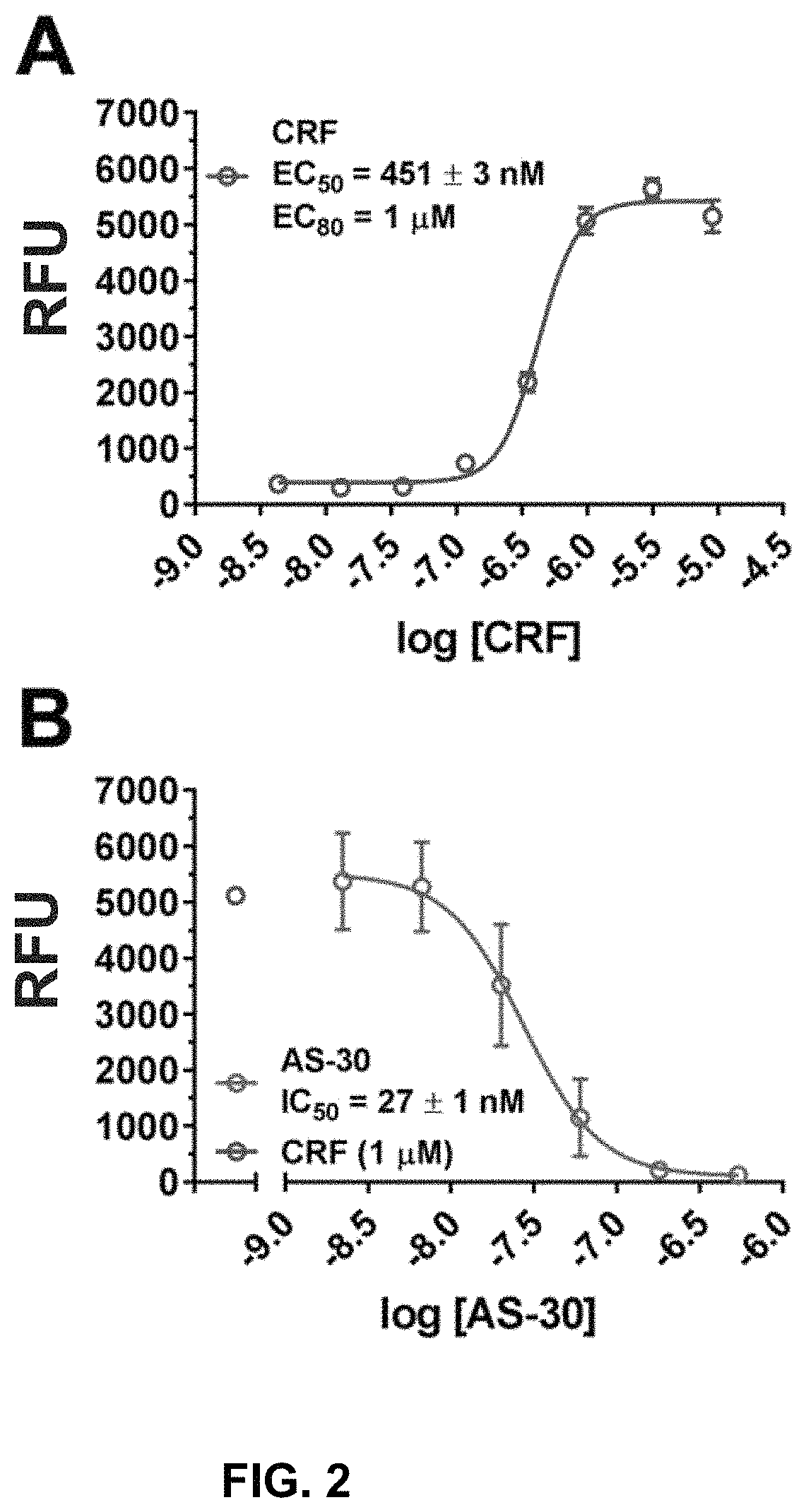Compositions and methods for the modulation of the corticotropin releasing factor binding protein and the treatment of alcohol use disorder
a technology of corticotropin and releasing factor, which is applied in the field of compositions and methods for the modulation of corticotropin releasing factor binding protein and the treatment of alcohol use disorder, can solve the problems of threatening both themselves and others, and aud continues to be a significant medical and social problem
- Summary
- Abstract
- Description
- Claims
- Application Information
AI Technical Summary
Benefits of technology
Problems solved by technology
Method used
Image
Examples
example 1
Materials and Methods
Materials
[0102]Materials and methods for the CRFBP-CRF receptor chimeras are extensively described in Haass-Koffler, et al. (2016).97 CRF, and the CRF2 specific inhibitor, antisauvagine 30 (AS-30, #A4727) were acquired form Sigma-Aldrich (St. Louis, Mo., US), FLIPR Calcium Assay Kits were purchased from Molecular Devices (Sunnyvale, Calif., US), and 96-well plates (black wall, clear bottom, BIOCOAT, #08774256) were purchased from Thermo Fisher Scientific (Waltham, Mass., US). [35S]-Guanosine 5′-(γ-thio)triphosphate ([35S]-GTPγS) (250 μCi; 9.25 MBq) was supplied from Perkin-Elmer® (Boston, USA). Guanosine 5′-[γ-thio]triphosphate tetralithium salt (GTPγS), guanosine 5′-diphosphate sodium salt (GDP), 2-hydroxy-ethylpiperazine-N-2-ethane sulphonic acid (HEPES), DL-dithiothreitol, tricine, magnesium chloride (MgCl2) ethylenediaminetetraacetic acid (EDTA) and saponin were purchased from Sigma-Aldrich® (St. Louis, USA). Complete mini protease inhibitor cocktail tablets...
example 2
Optimization and Miniaturization of the CRFBP-CRF2 Calcium Assay in 384-Well Plate Format
[0116]We recently published on the construction of a CRFBP-CRF2 chimeric complex and showed that this complex potentiates CRF-induced release of intracellular Ca2+ in 96-well fluorescence-based calcium assays.101 In order to further validate signaling from the CRFBP-CRF2 chimeric complex, CRF-mediated coupling of the chimera was measured in [35S]GTPγS binding assays to provide a convenient measure of CRF2 activity at the closest proximity to the receptor in the signaling cascade (FIG. 1). CRF produced a dose-dependent stimulation of [35S]GTPγS-binding in cell membranes expressing the FLAG-CRFBP(10 kD)-HA-CRF2α chimera (EC50=283±35 nM) (FIG. 1A). Furthermore, when CRF-stimulated (1 μM) [35S]GTPγS-binding was performed in the presence of AS-30 (10 nM-10 μM), the binding was inhibited (IC50=298±37 nM) (FIG. 1B).
[0117]To improve the throughput and to increase HTS readiness for implementation, the as...
example 3
Identification of CRFBP(10 kD)-CRF2 Modulators Using a Novel HTS of the Molecular Libraries Small Molecule Repository (MLSMR)
[0121]The MLPCN library of approximately 350,000 compounds was tested as a key component of our efforts to find modulators of the CRFBP(10 kD)-CRF2 receptor complex. This library was screened against our primary CRFBP-CRF2 cell-based Ca2+ assay, simultaneously screening for agonist and antagonist hits. Both screens performed well with an average plate Z′ of 0.60 and 0.59 for the agonist and antagonist screens, respectively.
[0122]During the performance of the screening campaigns, 1,568 hits with activity >50% of the CRF maximal response at a single concentration of 13.25 μM were identified in the agonist assay and 2,056 hits were identified in the antagonist assay with >50% inhibition of the CRF EC80 at 11.78 μM. The hit lists were first filtered cheminformatically to remove pan-assay interference compounds (PAINS) and compounds that have been deemed promiscuou...
PUM
| Property | Measurement | Unit |
|---|---|---|
| assay volumes | aaaaa | aaaaa |
| assay volumes | aaaaa | aaaaa |
| assay volumes | aaaaa | aaaaa |
Abstract
Description
Claims
Application Information
 Login to View More
Login to View More - R&D
- Intellectual Property
- Life Sciences
- Materials
- Tech Scout
- Unparalleled Data Quality
- Higher Quality Content
- 60% Fewer Hallucinations
Browse by: Latest US Patents, China's latest patents, Technical Efficacy Thesaurus, Application Domain, Technology Topic, Popular Technical Reports.
© 2025 PatSnap. All rights reserved.Legal|Privacy policy|Modern Slavery Act Transparency Statement|Sitemap|About US| Contact US: help@patsnap.com



